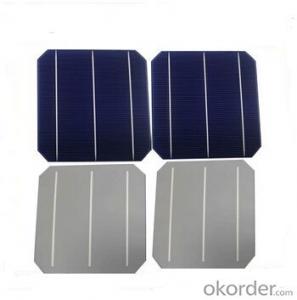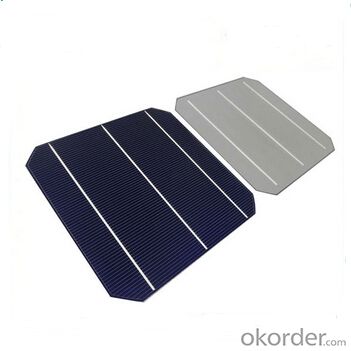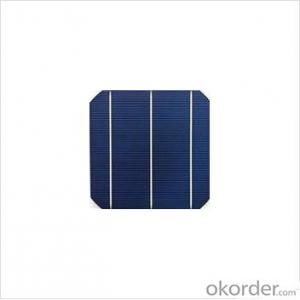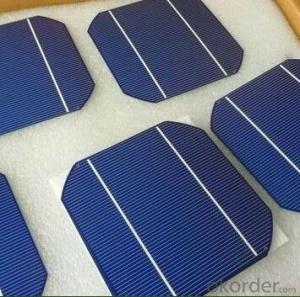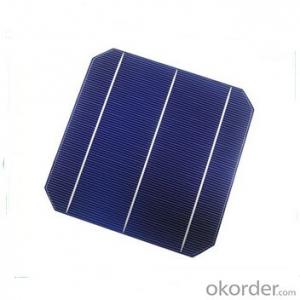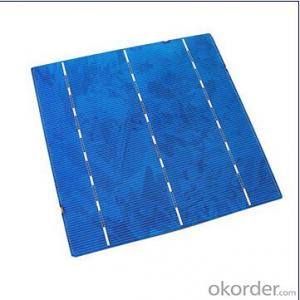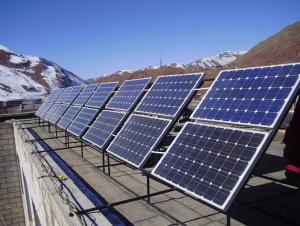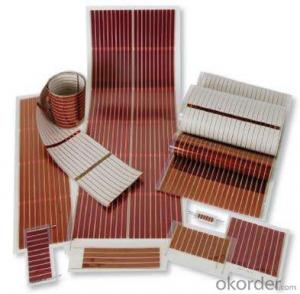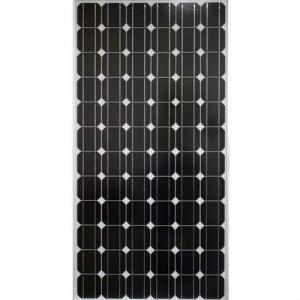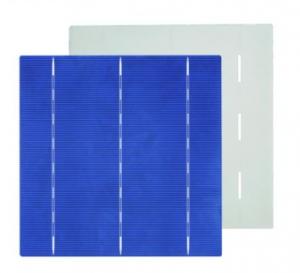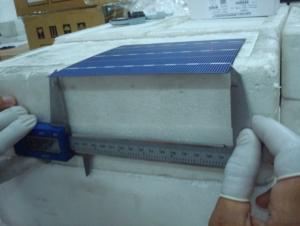High Quality Monocrystalline Solar Cells in Windows 16.40-17.60
- Loading Port:
- Shanghai
- Payment Terms:
- TT OR LC
- Min Order Qty:
- 1000 pc
- Supply Capability:
- 1000000 pc/month
OKorder Service Pledge
OKorder Financial Service
You Might Also Like
Solar Cells:
Solar cells is made by solar wafer, it has three categories of solar cell right now, monocrystalline polycrystalline and thin film,These cells are entirely based around the concept PN junction, which is the critical part of solar module, it is the part that can convert the light energy into electricity, the thickness is from 180um to 200um, with even busbars to conduct electricity, textured cell can decrease diffuse reflection; they are often electrically connected and encapsulated as a module. Photovoltaic modules often have a sheet of glass on the front (sun up) side, allowing light to pass while protecting semiconductor wafers from abrasion and impact due to wind-driven debris, rain, hail, etc. Solar cells are also usually connected in series in modules, creating an additive voltage. Connecting cells in parallel will yield a higher current;With high quality and stable quality. Our Cells can greatly improve the performance of Solar Modules.
Features:
1. High conversion efficiencies resulting in superior power output performance.
2. Outstanding power output even in low light or high temperature conditions
3. Optimized design for ease of soldering and lamination
4. Long-term stability, reliability and performance
5. Low breakage rate
6. Color uniformity
Solar Cells Advantage:
• High efficiency and stable performance in photovoltaic conversion.
• Advanced diffusion technique ensuring the homogeneity of energy conversion efficiency of the cell.
• Advanced PECVD film forming, providing a dark blue silicon nitride anti-reflection film of homogenous color and attractive appearance.
• High quality metal paste for back surface and electrode, ensuring good conductivity, high pulling strength and ease of soldering.
• High precision patterning using screen printing, ensuring accurate busbar location for ease with automatic soldering a laser cutting.
Specifications:
Dimensions | 156x156 mm |
Diagonal | 220 mm |
Cell Thickness | 180/200 ± 20μm |
Front | Blue silicon nitride anti-reflective coatings |
3x1.5mm silver busbar | |
Back | Full-surface aluminum back-surface field |
3x3.0mm (silver/aluminum) discontinuous soldering pads |
Electrical Characteristics | ||||||
Efficiency code | Efficiency Eff(%) | Power Pmax(W) | Max.Power Current Ipm(A) | Short Circuit Current Isc(A) | Max.Power Voltage Vpm(V) | Open Circuit Voltage Voc(V) |
1760 | 17.60 | 4.28 | 8.097 | 8.561 | 0.529 | 0.631 |
1740 | 17.40 | 4.23 | 8.035 | 8.506 | 0.527 | 0.629 |
1720 | 17.20 | 4.19 | 7.973 | 8.454 | 0.525 | 0.627 |
1700 | 17.00 | 4.14 | 7.910 | 8.398 | 0.523 | 0.625 |
1680 | 16.80 | 4.09 | 7.847 | 8.335 | 0.521 | 0.623 |
1660 | 16.60 | 4.04 | 7.769 | 8.267 | 0.520 | 0.622 |
1640 | 16.40 | 3.99 | 7.690 | 8.203 | 0.519 | 0.621 |
Packaging & Delivery of Solar Cells
Carton Box Package and Deliver by air. It should be noticed that it should be avoid of water, sunshine and moist.
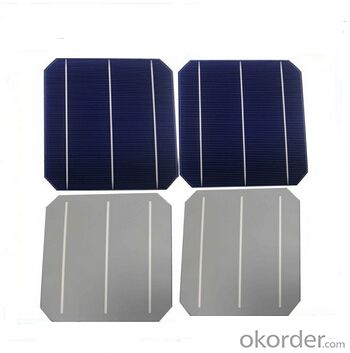

FAQ
We have organized several common questions for our clients,may help you sincerely:
①What price for each watt?
It depends on the efficiency of the solar cell, quantity, delivery date and payment terms.
②How long can we receive the product after purchase?
In the purchase of product within three working days, We will arrange the factory delivery as soon as possible. The pecific time of receiving is related to the state and position of customers.Commonly 7 to 10 working days can be served.
③Can you provide the peripheral products of the solar panels, such as the battery, controller, and inverter? If so, can you tell me how do they match each other?
Yes, we can, we have two companies for solar region, one is CNBM International, the other is CNBM engineering Co.
We can provide you not only the solar module but also the off grid solar system, we can also provide you service with on grid plant.
④What is your warranty of solar cell?
Our product can promise lower than 0.3% open box crack, we support claim after opening the box if it has crackm color difference or sth, the buyer should give pictures immediately, we can not accept the claim after the solar cell has assembled to solar panel.
• Timeliness of delivery
• ⑤How do you pack your products?
We have rich experience on how to pack the solar cell to make sure the safety on shipment, we could use wooden box or pallet as buyer's preference.
- Q: What is the role of solar cells in powering remote monitoring systems?
- Solar cells play a crucial role in powering remote monitoring systems by harnessing energy from the sun and converting it into electrical power. This ensures that these systems can operate efficiently and independently in remote locations where access to a traditional power grid may not be feasible or reliable. The solar cells collect sunlight and convert it into electricity, which is then stored in batteries or used directly to power the monitoring equipment. This sustainable and renewable energy source enables continuous operation of remote monitoring systems, making them more reliable and cost-effective in monitoring and collecting data in areas with limited or no access to conventional power sources.
- Q: Can solar cells be used on airplanes?
- Yes, solar cells can be used on airplanes. In fact, solar-powered airplanes have been developed and successfully flown, demonstrating the feasibility of harnessing solar energy for aircraft propulsion. Solar cells can be integrated into the wings or body of the airplane to capture sunlight and convert it into electrical energy, reducing reliance on traditional fuel sources and making air travel more sustainable.
- Q: Does the solar cell generate electricity in the absence of the sun, only in the case of strong lights or lasers? If you can achieve how much, and the same day?
- Strong light or laser light containing more than the threshold of solar cells can stimulate the solar cell power generation, if it does not contain, can not make too much battery power generation.
- Q: How do solar cells perform in areas with frequent tornadoes?
- Solar cells can still perform efficiently in areas with frequent tornadoes as they are designed to withstand extreme weather conditions. However, the installation and mounting of solar panels in tornado-prone regions should be done with utmost care and consideration of local building codes to ensure their resilience against high winds. Additionally, regular maintenance and inspection of the solar panels may be required to address any potential damage caused by tornadoes.
- Q: Can solar cells be used for lighting?
- Yes, solar cells can be used for lighting. Solar cells convert sunlight into electricity, which can be used to power lighting systems. This can be done by directly connecting the solar cells to the lighting fixtures or by storing the generated electricity in batteries for later use. Solar-powered lighting systems are environmentally friendly and can be a cost-effective solution for outdoor lighting, street lighting, and even indoor lighting in areas with limited access to electricity.
- Q: How do solar cells perform in areas with high levels of salt spray?
- Solar cells generally do not perform well in areas with high levels of salt spray. The salt particles can accumulate on the surface of the solar cells, reducing their efficiency by blocking sunlight and corroding the electrical components. Regular cleaning and maintenance are required to mitigate the negative impacts of salt spray on solar panels in such areas.
- Q: How are solar cells connected to the electrical grid?
- Solar cells are connected to the electrical grid through a process called grid-tied solar system. This involves installing an inverter that converts the direct current (DC) produced by the solar cells into alternating current (AC), which is the standard form of electricity used in the electrical grid. The AC electricity generated by the solar cells is then fed into the electrical grid through a bi-directional meter, allowing both the solar system to supply electricity to the grid when it produces excess power and receive electricity from the grid when the solar cells are not generating enough power. This connection enables solar energy to be seamlessly integrated into the existing electrical grid system.
- Q: Can solar cells be used in aviation or aerospace applications?
- Yes, solar cells can be used in aviation or aerospace applications. They are commonly used in satellites and space probes to generate electrical power from sunlight. Additionally, solar cells can be integrated into the wings or fuselage of aircraft to provide a sustainable source of energy, reducing reliance on fossil fuels and extending flight time.
- Q: What materials are used in solar cells?
- The materials used in solar cells primarily include silicon, which is the most commonly used semiconductor material, along with other elements such as gallium, indium, and selenium. These materials help convert sunlight into electricity through the photovoltaic effect.
- Q: Can solar cells be used to power agricultural irrigation systems?
- Yes, solar cells can be used to power agricultural irrigation systems. Solar panels can convert sunlight into electricity, which can be used to power pumps and other equipment necessary for irrigation. This renewable energy source can provide a sustainable and cost-effective solution for powering irrigation systems in remote or off-grid areas.
Send your message to us
High Quality Monocrystalline Solar Cells in Windows 16.40-17.60
- Loading Port:
- Shanghai
- Payment Terms:
- TT OR LC
- Min Order Qty:
- 1000 pc
- Supply Capability:
- 1000000 pc/month
OKorder Service Pledge
OKorder Financial Service
Similar products
Hot products
Hot Searches
Related keywords
